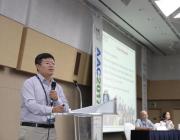摘要:
Understanding the evolution of aerosols in the atmosphere is of great importance for improving air quality and reducing aerosol-related uncertainties in global climate simulations. Here, a unique haze episode at a regional receptor site near the East China Sea was examined as a case study of the aging process of atmospheric aerosols during transport. An increase in photochemical age from 5 h. to more than 25 h and a progressive increase in the fitted mean particle diameter from 70 nm to approximately 300 nm were observed. According to the pollution features and meteorology conditions involved, pollution accumulation (PA), sea breeze (SB), and land breeze (LB) periods were identified. Concentrations of black carbon (BC), hydrocarbon-like organic aerosols (HOA), semi-volatile oxidized organic aerosols (SV-OOA), and nitrate increased by 7-fold up to 39-fold when the air masses passed through Taizhou, a nearby city. In addition, nitrate and SV-OOA dominated the aerosol composition in the urban outflow plumes (52% and 18%, respectively), yet they gradually decreased in concentration during transport. In contrast, sulfate and the low-volatile oxidized organic aerosols (LV-OOA) exhibited more regional footprints and potentially have similar formation mechanisms. The atomic oxygen-to-carbon (O/C) ratio also increased from 0.45 to 0.9, thereby suggesting that rapid formation of highly oxidized secondary organic aerosols (SOA) occurred during transport. Overall, these results provide valuable insight into the evolution of the chemical and physical features of aerosol pollution during transport and also highlight the need for regulatory controls of nitrogen oxides, sulfur dioxide, and VOCs to improve air quality on different scales. (C) 2016 Published by Elsevier Ltd.附注:
ISI Document Delivery No.: DZ1JZTimes Cited: 4Cited Reference Count: 44Peng, Jianfei Hu, Min Gong, Zhaoheng Tian, Xudong Wang, Ming Zheng, Jing Guo, Qingfeng Cao, Wei Lv, Wei Hu, Weiwei Wu, Zhijun Guo, SongWu, Zhijun/A-7041-2012; Peng, Jianfei/F-1438-2015; Hu, Weiwei/C-7892-2014; Guo, Song/D-9218-2012Guo, Song/0000-0002-9661-2313National Basic Research Program of the Ministry of Science and Technology of China [2013CB228503]; Strategic Priority Research Program of the Chinese Academy of Sciences [XDB05010500]; National Natural Science Foundation of China [21190052]; Environmental Monitoring Center of Zhejiang Province, ChinaThis research was supported by the National Basic Research Program (2013CB228503) of the Ministry of Science and Technology of China, the Strategic Priority Research Program of the Chinese Academy of Sciences (XDB05010500), the National Natural Science Foundation of China (21190052), and the Environmental Monitoring Center of Zhejiang Province, China. We thank Douglas R. Worsnop (Aerodyne Research Inc.) for insightful comments on this study.4565Elsevier sci ltdOxford1873-6424